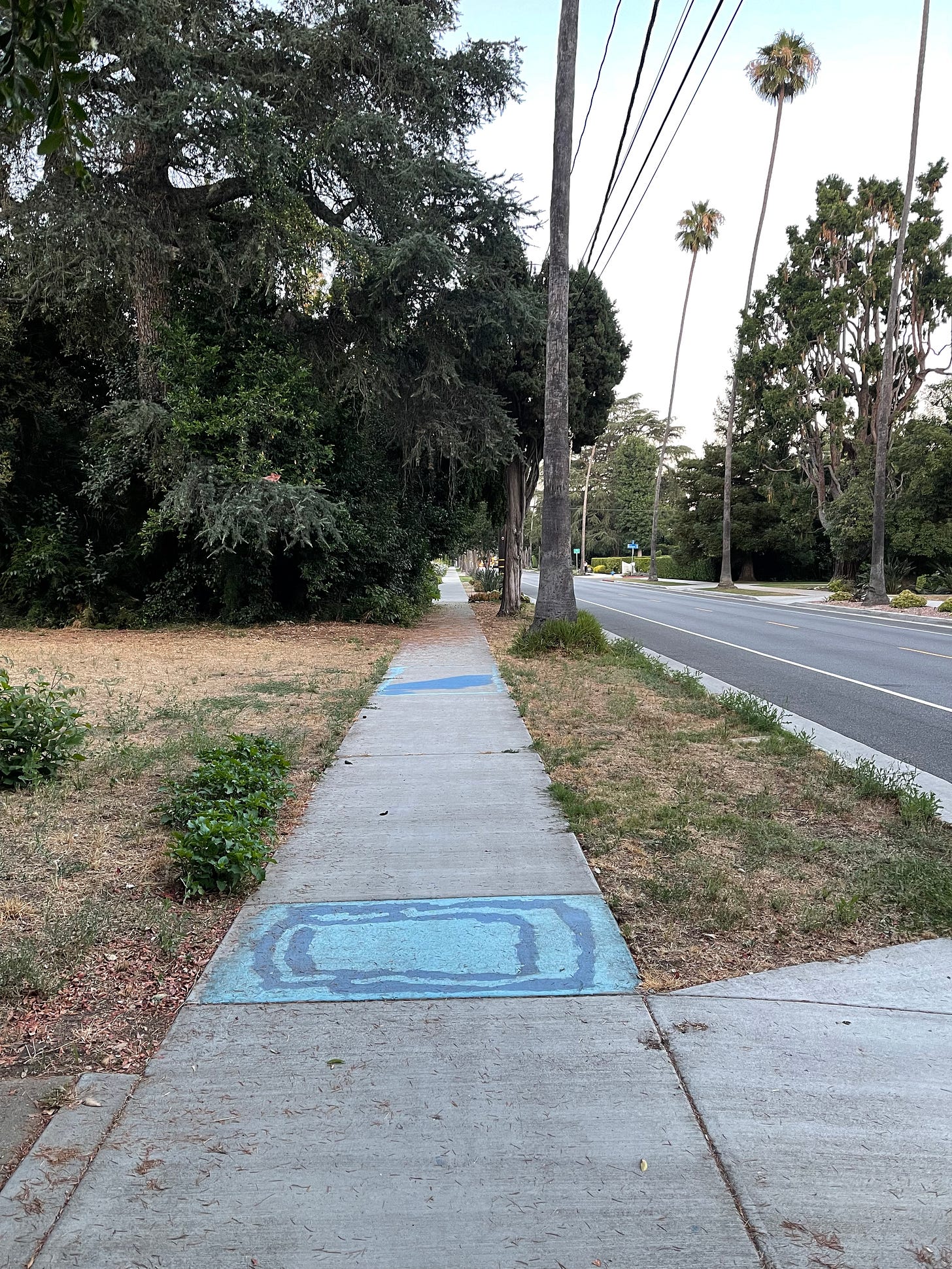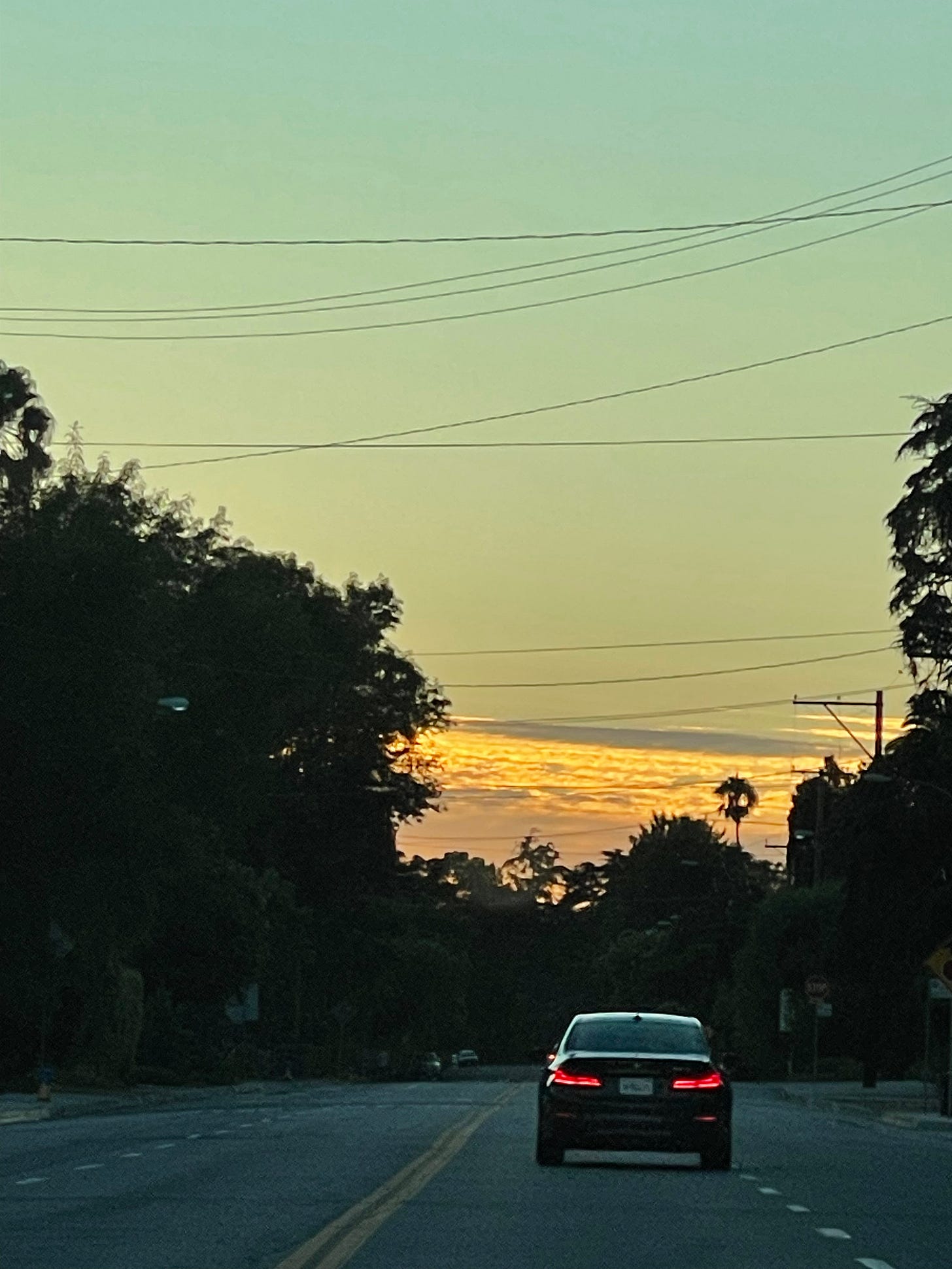the world is subtle
boring walks for writers: a noticing practice
Just about every day, I take a walk in my neighborhood.
It’s basically the same walk every day—so predictable that if J needs to find me for any reason after I’ve left, he knows exactly where I’ll be.
The route is determined in part because of my preferences. I like gentle, flat walks because they harmonize with my thoughts the best. I’m not sure it this has always been true, but I’ve discovered that really chill exercise agrees the best with me—pilates, breathing exercises, and walks at a relaxed pace. I do a little bit of an incline at the very beginning so the rest of the way is a very enjoyable coasting. It takes almost exactly 30 minutes.
You might think it’s boring to do the same walk every day, but I love it for this one crucial reason: Seeing the same places every day sharpens my ability to notice things.
Here are some examples:
There’s a trio of 50-something guys who play free jazz in a garage, then stand around on the sidewalk afterwards talking about insurance policies and fancy toilets. Sometimes I walk by when they’re playing, other times when they’re talking afterward. (If I didn’t do this same walk every day, I might only notice one part of this equation.)
After roses, agapanthis. After jacarandas, magnolias. After magnolias, myrtles.
There’s a well-decorated house with a nice garden and an art car in the driveway, but nobody seems to live there. The only time I’ve seen someone go inside, it was a delivery guy from a liquor store carrying a case of wine, and when I walked up, he gave me a hopeful look. He thought I might be the resident.
When it’s more temperate, people seem to do their walks at varying times, but when it’s been so hot, almost everybody leaves the house at 7:30 because it’s the first time things have cooled off enough, and just long enough before it gets dark.
A few months ago, when it was comparatively cold and rainy, unusual for here, I went for a walk the first day the sun really broke through. It hadn’t been out in weeks, so I ran out the door the second the sky cleared. And I saw so, so, so many lizards—all of them clearly doing exactly what I was.
I watch the life cycle of houses selling—the real estate agent’s sign, the anemic staging furniture, the temporary emptiness after its sells, and then you can see the new owner inside with their boxes. Sometimes a NASA dumpster arrives in the driveway (I live near Jet Propulsion Laboratories, so this isn’t as crazy as it sounds). One place with an incredible mountain view behind it I loved so much that I actually went to the open house and negged the realtor about the fake gas logs in the fireplace. For a little while, I walked by it every chance I got and mentally lived there. Imagined coming home to there. But then it sold, and a big, red bow appeared on the front door. All the weird rusted bedsprings and old high chairs from the garage came out to the curb. Then the ribbon disappeared, and the stuff on the curb disappeared. Nobody has moved in yet.
About a month ago, I started noticing dog turds all over the sidewalk on one particular block. And then a few weeks later, I saw four coyotes trotting down that street.
In my neighborhood it is common practice to leave a box of lemons or grapefruits at the edge of the sidewalk, free to all. One house always has actual produce—massive amounts of cucumbers and zucchini. Oddly, the yard is brown. They must be in the process of putting in xeriscaping or something, but it seems strange that the greatest bounty comes from the most barren place. Finally, last week, I saw the woman who puts out so many vegetables and got to thank her.
The day before the hurricane, it smelled like ozone. The day after, it smelled like dirt.
If I ever teach at an MFA program, I would require students to go on a simple, completely non-sensational walk near their home at least three times a week, with the only goal of noticing new things. Because the world is sensational, actually. The ordinary world! It is subtle. It is a map with thousands of translucent layers. If you aren’t careful, it is possible to forget that you are locally eligible for joy and beauty and mystery. Forgetting that these things are always available and near is the surest way to feel unhappy. Seeing thousands and thousands of images from other lives and finding them interesting doesn’t necessarily have to make our own lives seem flat and dissatisfying, but I think it can happen accidentally, without intervention. Because we’re human, our intelligence relies upon making distinctions. Distinctions are comparisons. And we have a survival-driven negativity bias, which means we tend to compare in terms of what one thing or the other lacks. (“One of these things is not like the others!”)
But something interesting can happen to this discriminating intelligence when you apply it to the same, fairly ordinary thing every day: You continue to make distinctions, but because you’re looking at the same object and place and plant and turtle pond every day, you begin to notice shades of it. You compare today’s layer with yesterday’s layer. Much better than comparing yourself with someone who seems to always have a perfect haircut, eating a perfect crepe.
Discriminating intelligence is like any tool: it can be used well and poorly. In writing workshops, discriminating intelligence is used poorly if the objective is to say what’s wrong with a text. But it can be used well if the objective is to continue seeing new layers and subtleties. Brigit Pegeen Kelly’s poetry workshops were genius because she didn’t really permit (in her very kind and steadfast way) editorializing. Each person was to continue noticing something about the poem, with no repeats. Which meant that once the fairly obvious observations were managed, you had to keep looking at, looking at. And because you were restrained to noticing something on the page, you couldn’t really render an opinion. Because—aha—your opinion is not actually on the page.
Likewise, your opinion is not actually in the world.
It is important, for some reason, that these walks happen close to home. They can’t be too much of a destination (although when I was living in the mountains last year, my walks were typically a short car ride away because people drive so fast and the roads are so twisty that you can only walk in peace on a trail of some kind). I think this is because home is where you most need to be reminded of the possibility to be surprised. It is too easy for a house to become a machine that makes the same version of you every day. That’s how years disappear: in houses. But years don’t exist in a neighborhood at dusk with a pack of four coyotes trotting down the sidewalk. The world breathes and the world can hold its breath forever. They’re both true. The sprinklers go off.
Thank you for reading! I hope you stick around. Please send your neighborhood lizards my regards.





